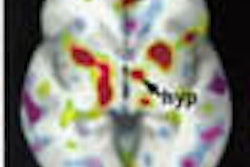Researchers from the VA Palo Alto Health Care System and Stanford University found that FDG-PET delivered the high sensitivity rates typically reported for non-small cell carcinomas, and an ability to detect small-cell cancers not emphasized in previous literature. And while PET's negative predictive value is good, it is unreliable for some types of cancer, they said at the Chest 2000 conference last month in San Francisco.
"Lung cancer is the leading cause of cancer deaths in men and women, and recent reports have suggested that out of 130,000 solitary pulmonary nodules (SPN) identified in the U.S., 30%-50% are malignant," said Dr. Shirin Shafazand, a fellow at Stanford University Medical Center in Stanford, CA. Conversely, more than half of resected lung nodules are benign, she said, meaning that these patients are needlessly subjected to surgery for lack of better diagnostic methods.
Thus the search continues for the most accurate and least invasive diagnostic tools, and for clear indications on when to use which available method. Because it is both noninvasive and often highly accurate, FDG-PET is emerging as a useful tool in the diagnosis and staging of lung cancer, and has been adopted widely in the U.S., Shafazand said.
The Stanford group conducted a retrospective analysis of histological results on a population of veterans with a high incidence of lung cancer. The patients, all smokers or ex-smokers, included 100 men and one woman (ages 40-91, mean 64) who were referred to the center for suspicious lung mass or nodules between 1997 and 1999. Patients without histological confirmation of diagnosis were excluded from the study.
Most patients were asymptomatic, or were referred from outside hospitals without information on presenting symptoms. Increasing dyspnea was the most common symptom, seen in 13 patients. Among other symptoms were hemoptysis in 11 patients, and bone pain suggestive of possible metastasis in 6, she said.
"Diagnosis was established by sputum cytology in 9 cases, fine-needle aspiration in 35, bronchoscopy and biopsy in 17, and the vast majority by traditional or video-assisted thoracotomy," Shafazand said.
Attenuation-corrected emission scans of the thorax were acquired 60 minutes after the injection of 2-F-18 fluoro-2-deoxy-D-glucose (FDG). Whole-body scans without attenuation were also obtained, and the results were presented in axial, coronal, and sagittal planes.
"Out of 101 patients there were 94 neoplasms determined. Squamous-cell carcinomas were the vast majority with 43 cases," Shafazand said. In addition, there were 30 adenocarcinomas, three large-cell cancers, five poorly differentiated carcinomas, and 13 small-cell carcinomas. There were seven patients with benign conditions, including organizing pneumonitis (1) coccidiomycosis (2), and sarcoidosis (1).
In 92 cases in which pathology was negative, the PET scan was also negative. In three cases where the pathology was negative, the PET scan was negative. There were 92 true negatives, two false positives, and four false negatives.
The team reported 98% sensitivity for cancer, a figure in line with studies published over the past decade. However, the 48% specificity was lower than previously published ranges of 63%-90%. Specificity was underestimated due to study criteria that included only patients for whom histopathological results were available. As a result, a large number of PET scans were negative, underestimating the true negative rate and thus specificity, she said.
"There were multiple foci of uptake in metastases, and PET was very helpful in determining that right off the bat," Shafazand said. Noting that PET also found 13 small-cell cancers, she said "most of the data in PET scanning has been related to non-small cell lung cancer, when in fact small-cell lung cancer is also glucose-avid, and [detection] is comparable to non-small cell lung cancer. Particularly in combination with thoracic CT, PET can be used to distinguish limited-stage from extensive-stage disease. As we get more experienced with this, PET will definitely play a role in the identification of distal metastases, and both small-cell and non-small cell lung cancer."
The study also concluded that the negative predictive value of PET decreased the likelihood of lung cancer to the point where routine clinical and radiographic follow-up would be sufficient in the face of a negative PET result. However, an audience member at Shafazand's presentation disagreed with that conclusion, noting that PET routinely misses tumors smaller than 8 mm, and many alveolar and carcinoid tumors as well.
By Eric BarnesAuntMinnie.com staff writer
November 9, 2000
Related Reading
Testing the test: lung cancer staging with CT, PET, TBNA, and mediastinoscopy, November 3, 2000
Dedicated PET and hybrid PET are equally accurate for assessing lung cancer, October 25, 2000
Let AuntMinnie.com know what you think about this story.
Copyright © 2000 AuntMinnie.com




















